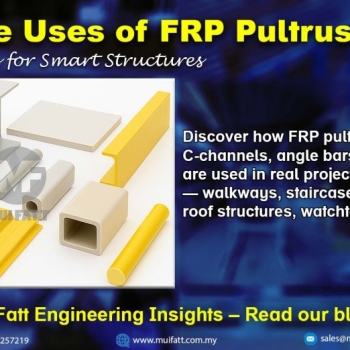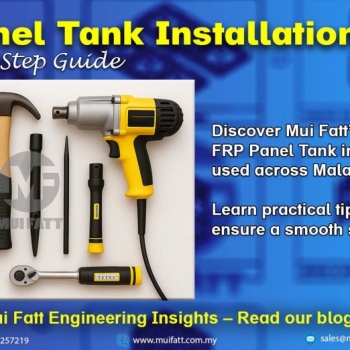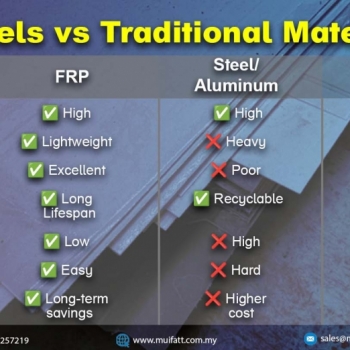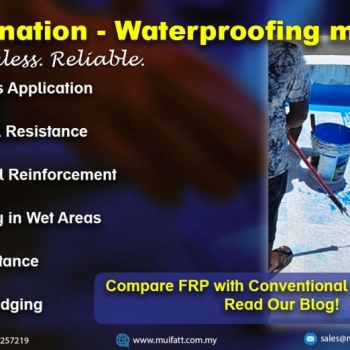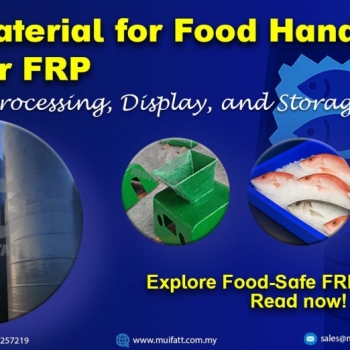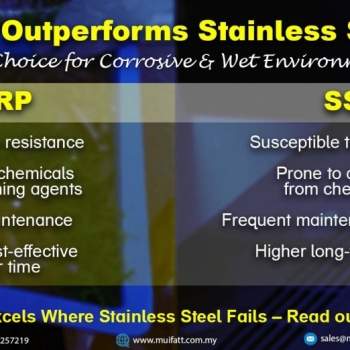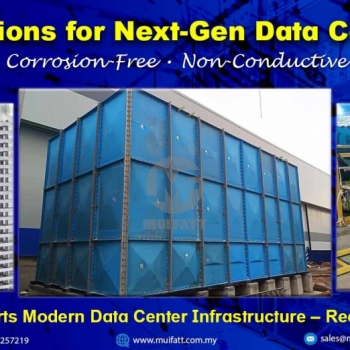FRP pultruded profiles are reshaping structural possibilities across Malaysia. From STP staircases to public park shelters, explore how these modular components enable custom FRP solutions—only from Mui Fatt.
The Essential Guide to Kickplates: Safety, Style & Compliance
22 Jan 2025
- Key Takeaways
- Understanding Kickplates
- Key Functions of Kickplates
- Where Are Kickplates Commonly Installed?
- Material Comparison: Why FRP Stands Out
- Why Choose Mui Fatt for Your Kickplate Needs?
- Frequently Asked Questions (FAQs)
Key Takeaways
-
Kickplates are protective panels installed at the base of doors, walls, or railings to prevent damage and enhance safety.
-
They are also known as toe kicks, door kickplates, or wall base protectors.
-
Functions include improving safety, accessibility, aesthetics, and ensuring building code compliance.
-
FRP kickplates offer superior durability, corrosion resistance, and lightweight properties compared to other materials.
Kickplates are essential yet often overlooked components in both residential and commercial spaces. Positioned at the bottom of doors, handrails, or walls, kickplates serve critical functions that enhance safety, improve accessibility, comply with building codes, and even contribute to aesthetics. This article explores their purpose, functions, and why fiberglass-reinforced plastic (FRP) kickplates stand out among other materials.
Understanding Kickplates
What is a Kickplate?
A kickplate is a protective panel or strip installed at the base of doors, walls, or railings. Commonly made from materials like metal, plastic, or fiberglass, kickplates shield surfaces from damage caused by foot traffic, carts, or machinery.
Other Common Names for Kickplates
-
Toe kick
-
Door kickplate
-
Handrail kickplate
-
Wall base protector
Key Functions of Kickplates
Ensuring Safety in Commercial and Residential Spaces
Kickplates act as barriers to prevent tripping hazards and guard surfaces from wear and tear, particularly in high-traffic areas. By reducing impact damage, they ensure long-lasting structural integrity and safer environments.
Enhancing Aesthetic Appeal
Far from being merely functional, modern kickplates come in various colors, finishes, and materials to complement interior or exterior designs. FRP kickplates, in particular, allow for color customization, providing both durability and visual harmony.
Improving Accessibility in Compliance with ADA*
Kickplates improve accessibility for people using wheelchairs, walkers, or carts by protecting lower door panels and facilitating smoother navigation.
*Explore more on ADA compliance for accessibility
Meeting Building Code Requirements
Many building codes mandate using kickplates in commercial spaces to ensure doors, walls, and railings can withstand repeated use. They also contribute to fire-resistant and corrosion-proof structures when crafted from appropriate materials like FRP.
Where Are Kickplates Commonly Installed?
-
Doors: Protects against scuff marks caused by foot traffic.
-
Handrails: Prevents damage from collisions in industrial or commercial settings.
-
Walls: Guards lower walls in areas where carts or heavy machinery are used.
Additional Applications of FRP Kickplates:
-
Medical Facilities: FRP kickplates resist moisture and chemicals, making them ideal for hospitals and labs.
-
Kitchens: Durable against heavy use, FRP kickplates are a practical choice in commercial kitchens.
-
Retail Spaces: Protects walls and fixtures in busy shopping areas.
Material Comparison: Why FRP Stands Out
When selecting a kickplate, the choice of material is crucial. Below is a comparison of popular materials, highlighting the superiority of FRP:
| Material | Strengths | Weaknesses |
|---|---|---|
| Stainless Steel | Durable, corrosion-resistant, and aesthetic appeal | Heavy, expensive, and prone to dents |
| Aluminum | Lightweight and cost-effective | Not as durable and less impact-resistant |
| Wood | Provides a classic look | Prone to warping, rotting, and requires regular maintenance |
| Plastic (PVC) | Lightweight and affordable | Less durable, susceptible to UV degradation |
| FRP | High durability, lightweight, corrosion-resistant, customizable, and low maintenance | Slightly higher initial cost but offers better long-term value |
Benefits of FRP Kickplates from Mui Fatt
-
Durability - FRP kickplates withstand significant wear and tear, making them ideal for industrial and commercial applications.
-
Lightweight and Easy Maintenance - Despite their strength, FRP kickplates are lightweight and require minimal upkeep, saving time and costs over time.
-
Corrosion Resistance - Unlike metals, FRP is resistant to rust, making it an excellent choice for humid or corrosive environments.
Why Choose Mui Fatt for Your Kickplate Needs?
Proven Expertise in Manufacturing
With over 40 years of experience, Mui Fatt delivers industry-leading FRP and PE products tailored to customer needs.
Customized Solutions Tailored for You
From specific dimensions to color preferences, Mui Fatt’s kickplates are designed to integrate with your space seamlessly. Contact us via WhatsApp or email at sales@muifatt.com.my to understand more!
Frequently Asked Questions (FAQs)
What is a kickplate?
A kickplate is a protective panel installed at the bottom of doors, handrails, or walls to prevent damage and enhance durability.
Where are kickplates most commonly installed?
They are typically installed on doors, handrails, or walls in both residential and commercial spaces.
How does a kickplate improve safety?
Kickplates protect surfaces from impact damage, preventing hazards such as tripping or structural weakening.
Can kickplates enhance the aesthetic of a space?
Yes, modern kickplates, including FRP options, come in various colors and designs to complement your decor.
Are kickplates required by building codes?
Many building codes recommend or mandate kickplates in high-traffic commercial spaces.
How are FRP kickplates better than traditional materials?
FRP offers unmatched durability, lightweight design, corrosion resistance, and customization options compared to traditional materials.
#kickplatepurpose #toekick #doorkickplate #handrailkickplate #kickplatesafety #accessibilitykickplate #kickplatedesigncompliance
Disclaimer:-
The content on this site is for general information and entertainment purposes and does not constitute legal counsel. We strive to keep our information as accurate as possible. However, we make no warranties about the completeness, accuracy, reliability, suitability, or availability with respect to the information contained on this page. You should rely on this information at your own risk. This website may include links to other third-party sites. These links are provided as a convenience to you as a reader, user, or browser only. We make no representation, warranty, or guarantee, nor do we endorse or take responsibility for any of the content of such sites.
Stay in touch with us if you’re interested in hearing from us promptly.
- Website - https://www.muifatt.com.my/home/
- Facebook - https://www.facebook.com/muifattmarketing
- Instagram - https://www.instagram.com/muifattmarketing/
- Google - https://goo.gl/maps/WxVY13gNcaRTS7Jp6
- Youtube - http://www.youtube.com/@MuiFattMarketing
- TikTok - https://www.tiktok.com/@muifattmarketing
- LinkedIn - https://www.linkedin.com/company/mui-fatt-marketing-sdn-bhd-
- Linktree - https://linktr.ee/muifattmarketing
- Shopee - https://www.shopee.com.my/muifattmarketing
- Lazada - https://www.lazada.com.my/shop/mui-fatt-marketing
Recent Blog
Mui Fatt Engineering Insights - FRP Panel Tank Installation
Get to know the step-by-step assembly process of FRP sectional panel tanks, based on Mui Fatt’s industry-proven practices. This easy-to-digest guide is ideal for project managers, contractors, and technical personnel involved in water storage tank installation across Malaysia.
FRP Panels vs Traditional Alternatives: The Ultimate Guide to Durability and Sustainability
Explore why FRP (Fiberglass-Reinforced Plastic) panels outperform traditional materials like steel, plywood, and PVC in durability, sustainability, and cost-effectiveness. Discover real-world applications in MyKiosk projects and cold truck panel assembly, where FRP’s superior insulation, corrosion resistance, and lightweight properties deliver long-term benefits.
Comparing FRP Waterproofing with Traditional Systems
Is FRP lamination a better waterproofing method than traditional systems? Explore this complete guide with real project examples and see why FRP is gaining traction across Malaysia.
Benefits of FRP in Food Handling & Processing
With hygiene, durability, and corrosion resistance at its core, FRP (Fibreglass Reinforced Plastic) is becoming a preferred material in the food industry. This article explores why FRP is ideal for food handling equipment such as supermarket fish trays, water tanks, and food factory platforms, plus how Mui Fatt is delivering proven solutions through its successful FRP applications.
Mui Fatt Insights: Advanced Materials for Modern Needs
Is stainless steel the best for wet areas? This article explains why more industries are switching to FRP for its corrosion resistance, hygiene benefits, and longevity, especially in food displays and chemical exposure zones.
How FRP Supports Modern Data Center Infrastructure
Discover how fiberglass-reinforced plastic (FRP) is reshaping data center construction. Learn its key advantages, comparisons with other materials, and where to apply FRP—from rooftop chillers to cooling tanks.
Understanding FRP Filament Winding: Process, Benefits & Comparison
This article explores the FRP filament winding manufacturing method, how it differs from other FRP techniques, why it’s still widely used, and its long-term value for projects like high-strength tanks and cylinders.
